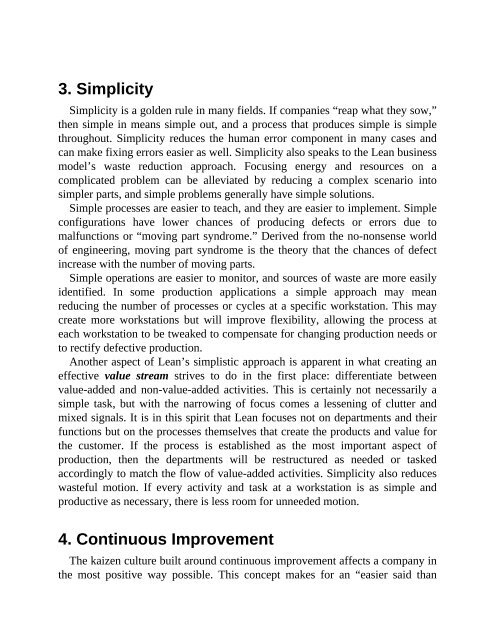Lean QuickStart Guide_ The Simplified Beginner’s Guide to Lean - PDF Room
You also want an ePaper? Increase the reach of your titles
YUMPU automatically turns print PDFs into web optimized ePapers that Google loves.
3. Simplicity<br />
Simplicity is a golden rule in many fields. If companies “reap what they sow,”<br />
then simple in means simple out, and a process that produces simple is simple<br />
throughout. Simplicity reduces the human error component in many cases and<br />
can make fixing errors easier as well. Simplicity also speaks <strong>to</strong> the <strong>Lean</strong> business<br />
model’s waste reduction approach. Focusing energy and resources on a<br />
complicated problem can be alleviated by reducing a complex scenario in<strong>to</strong><br />
simpler parts, and simple problems generally have simple solutions.<br />
Simple processes are easier <strong>to</strong> teach, and they are easier <strong>to</strong> implement. Simple<br />
configurations have lower chances of producing defects or errors due <strong>to</strong><br />
malfunctions or “moving part syndrome.” Derived from the no-nonsense world<br />
of engineering, moving part syndrome is the theory that the chances of defect<br />
increase with the number of moving parts.<br />
Simple operations are easier <strong>to</strong> moni<strong>to</strong>r, and sources of waste are more easily<br />
identified. In some production applications a simple approach may mean<br />
reducing the number of processes or cycles at a specific workstation. This may<br />
create more workstations but will improve flexibility, allowing the process at<br />
each workstation <strong>to</strong> be tweaked <strong>to</strong> compensate for changing production needs or<br />
<strong>to</strong> rectify defective production.<br />
Another aspect of <strong>Lean</strong>’s simplistic approach is apparent in what creating an<br />
effective value stream strives <strong>to</strong> do in the first place: differentiate between<br />
value-added and non-value-added activities. This is certainly not necessarily a<br />
simple task, but with the narrowing of focus comes a lessening of clutter and<br />
mixed signals. It is in this spirit that <strong>Lean</strong> focuses not on departments and their<br />
functions but on the processes themselves that create the products and value for<br />
the cus<strong>to</strong>mer. If the process is established as the most important aspect of<br />
production, then the departments will be restructured as needed or tasked<br />
accordingly <strong>to</strong> match the flow of value-added activities. Simplicity also reduces<br />
wasteful motion. If every activity and task at a workstation is as simple and<br />
productive as necessary, there is less room for unneeded motion.<br />
4. Continuous Improvement<br />
<strong>The</strong> kaizen culture built around continuous improvement affects a company in<br />
the most positive way possible. This concept makes for an “easier said than






